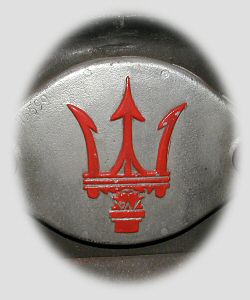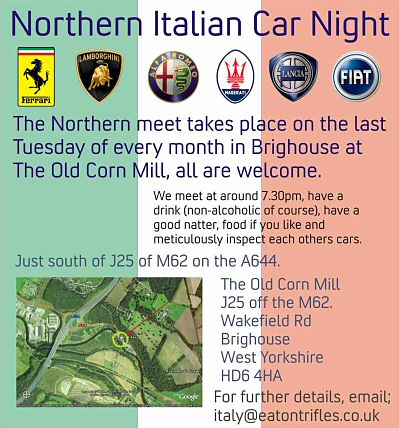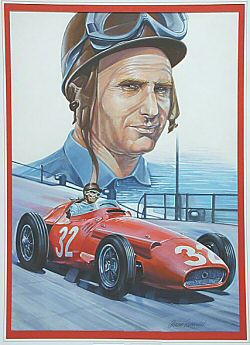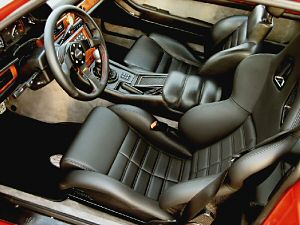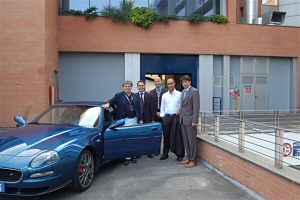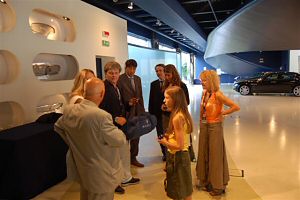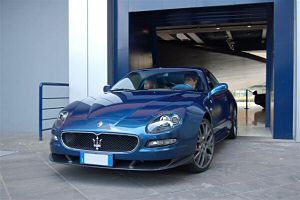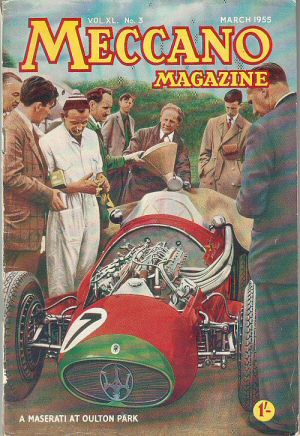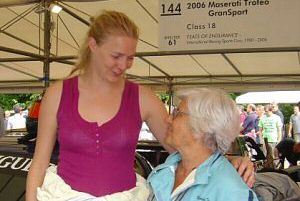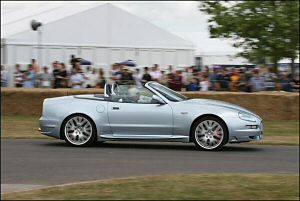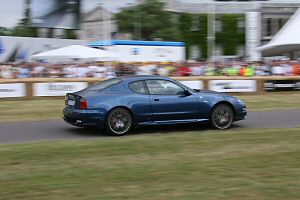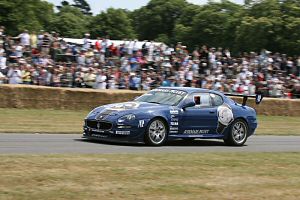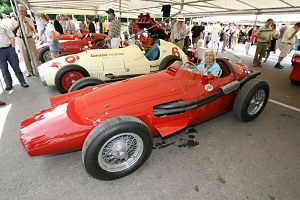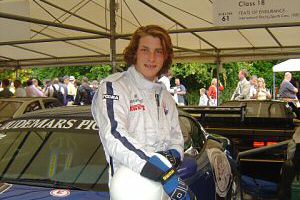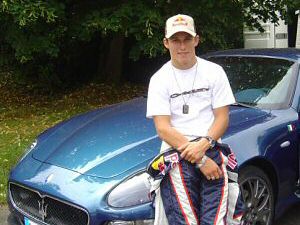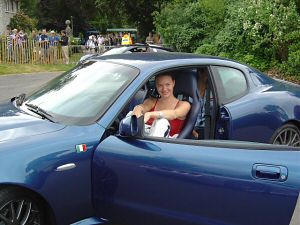|
Meccano Magazine was published from 1916 to 1981. It was a general purpose boy's magazine primarily aimed at Meccano enthusiasts, but it also featured articles on variety of interesting subjects. One of those interesting articles was this one:
"MOSS AND HIS MASERATIS IN 1954.
Our cover this month, which is based on a photograph taken by W. R. Hamilton, Cheadle Huhne, a reader of the M.M.,
shows Alf Francis, who is first mechanic for Stirling Moss, at work on the Maserati in which that great driver took part in two races at the Oulton Park International Motor Racing meeting organised by the Mid-Cheshire Car Club and the Daily Dispatch in August last. This car was not Stirling's own Maserati, in which he had won at Aintree earlier in the year. This had suffered engine troubles in a previous event, and the car seen on the cover is a special one that was flown over at short notice, so that Stirling could take part in this meeting.
The Maserati of course is an Italian car, and is seen painted red, the racing colour of Italy, but the nose of the machine is painted green, the English racing colour, in view of Stirling's own nationality. It is numbered 7. Stirling
always takes this number whenever possible, as he likes it and thinks of it as his lucky number. The Maserati in which he raced at Aintree at the Spring and Autumn meetings of last year also was numbered 7. Another interesting
point is that Stirling's cars always have on them a small Union Jack, an adornment on which he insists.
Flying the car over to this country from Italy, and the meticulous preparation that Alf Francis gave it, brought their full reward in the two events for which it was entered, for Stirling won both. The first was a 100-mile Formula l Gold Cup race, in which Stirling's average speed was 83.48 m.p.h. The second was a Formule Libre 75-mile event in which his average was 82.91 m.p.h. His full out speed on the course was about 140 m.p.h.
I last saw Stirling on the day before the Autumn Motor Racing meeting at Aintree, Liverpool. As we parted he asked me what kind of weather Liverpool had in store for the meeting next day. I immediately said that the afternoon would be fine and dry, and added that he himself would win all three of the races for which he was entered. He seemed amused.
But the afternoon was fine and he did win all the events in which he took part.
It was certainly Stirling's day at Aintree on 2nd October last. He was driving a Maserati in two of the races. One of these was the Daily Telegraph Trophy Race of 17 laps, in which he took the lead immediately and maintained it
throughout, at the end leading Mike Hawthorn in the Vauxhall Special, his average speed being 85.43 m.p.h. The second was the Formule Libre Race, also of 17 laps, and in winning this event he set up a record for the Aintree course by
completing the fastest lap, at 89.55 m.p.h.
The third race was in the 500 c.c. class, in which Stirling drove a Beart-Cooper Norton. Here again he ran right away from the field at the start and continually increased his lead, showing his remarkable style and capacity throughout.
Aintree looks like being a happy hunting ground for Stirling. So far only two meetings have been held there, the one
I have just referred to and the opening meeting in blay of last year. On the latter occasion he won the Formule
Libre Aintree 200, the final of which consisted of 34 laps, in his Maserati, with the average speed of 77.7 m.p.h.
Again he won the 500 c.c. scratch race in the Beart-Cooper Norton, his run including the fastest lap at 72.19 m.p.h.
Returning for a moment to the Autumn Aintree meeting, I wonder how many readers noted the remarkable eight days in Stirling's racing career that ended there. These began at Goodwood, on the previous Saturday, when the Autumn meeting of the B.A.R.C. was held. The big race of that day was the Goodwood Trophy, 21 laps, in which Stirling drove in his calm and easy fashion to finish in the lead, the average speed over this course being 91.49 m.p h. He also made the fastest lap at almost 93 m.p.h. On that day he also scored two seconds and a third. The first of his seconds was in a 500 c.c. race, the second in a sports car race in which he drove a Lister-Bristol, and his third was achieved in the Woodcote Cup, in which he drove a Maserati. Incidentally, he made the fastest lap in the first two of these three races also, and in the 500 c.c. race he created a Goodwood lap record for cars of that capacity, 83.88 m.p.h.
Now just look back over these events, and you will realise that he won races at first class meetings in three widely different types of car, namely the 500 c.c. class, a sports car and the Maserati, a car designed and constructed with Grand Prix racing in view. Remembering also his achievements in such famous Rallies as the Monte Carlo and Alpine events, this shows that Stirling is no specialist, but is the complete motorist, capable of holding his own in all aspects of motor sport. His style and the ease of his driving make this possible. He understands cars, and is a master of the art of "taking them along" to get what he wants from them.
I am not sure that "driving" is the right word for this art, for it rather implies compulsion or force, and Stirling does not force his cars at all; he persuades them, with hands and feet that he moves thoughtfully and at exactly the right time to achieve what he wants in the most economical way, one that is calculated to allow the car itself to give full vent to its power. I suppose that there are racing drivers whose movements are violently energetic, and who themselves radiate an air of power proportional to that of the cars they drive. But that is not the way of the masters.
To illustrate this let me take you to a race that Stirling lost, a race that to me reveals one of the qualities that lie behind his remarkable successes in the motor racing world. This was the Italian Grand Prix at Monza in September of last year, a race that calls for high speed and acceleration. In it Stirling was battling with such famous
drivers as Fangio, in a Mercedes-Benz, and Ascari, both world champions, with Gonzalez, Villoresi, Mike Hawthorn and many others.
Driving steadily and easily, Moss eventually came into third place, within reach of the two leaders, Fangio in his Mercedes-Benz and Ascari in his Ferrari. At the half distance the latter was a second ahead of Fangio and behind these came Moss and Villoresi, also in a Maserati. The two latter moved up, and then Villoresi tackled the leaders, only to retire with his clutch out of order. Moss now took up the running. First he swept past Fangio and then on the 45th lap he passed Ascari, and once in the lead, with the two greatest drivers of the present age pressing him, he drove on completely at ease and unruffled.
Perhaps it is very easy to be unruffled when leading or winning, but how many of us can preserve calm when our hopes and expectations are suddenly crushed? With 10 laps to go, and still leading, 20 seconds ahead of Fangio, Stirling suddenly found that his oil pressure was falling. He pulled into the pit, more oil was hastily poured in and off he went again in pursuit of Fangio, who in the meantime had gone ahead. But oil was streaming out of the tail of his car, and before he could stop the engine seized. With victory seemingly in his grasp, he was out of the race.
What had happened was that an unsupported length of pipe flanged to the oil tank at the rear had cracked the tank at the flange. Otherwise the car was in perfect order, thanks to Alf Francis, who had assembled it himself.
There were no loud complaints or wailings from Stirling. He simply pushed his car up to the finishing line, and there waited calmly until the leader had completed the 80 laps of the course. Then he pushed it over the line, and so scored 10th place in this remarkable race. This was at a time when Stirling suffered two or three cruel blows of fate, but he took them all in the same calm and easy manner.
Fangio and Gonzales have had similar experiences, and have just sat quietly watching after mishaps have deprived them of success. Lesser mortals would have been moved to anguish, but these men are masters, and with them Stirling undoubtedly ranks. He has been rightly bracketed with Fangio, Ascari, Gonzales and Farina, who with him make up the five greatest figures of the racing world.
Will Stirling achieve his greatest ambition, that of bringing the World Championship to Britain? The 1955 Grand Prix programme will show. Stirling has now joined the Mercedes-Benz team. The invitation to do so was in itself a great tribute to him, and he was right to accept it in the absence at present of a British car with a powerful organisation behind it that could give him the opportunity of bringing the Championship to this country. He has won the B.R.D.C. Gold Star four times in the last five years; may he create a similar record in the World Championship." |


